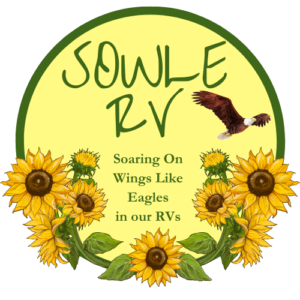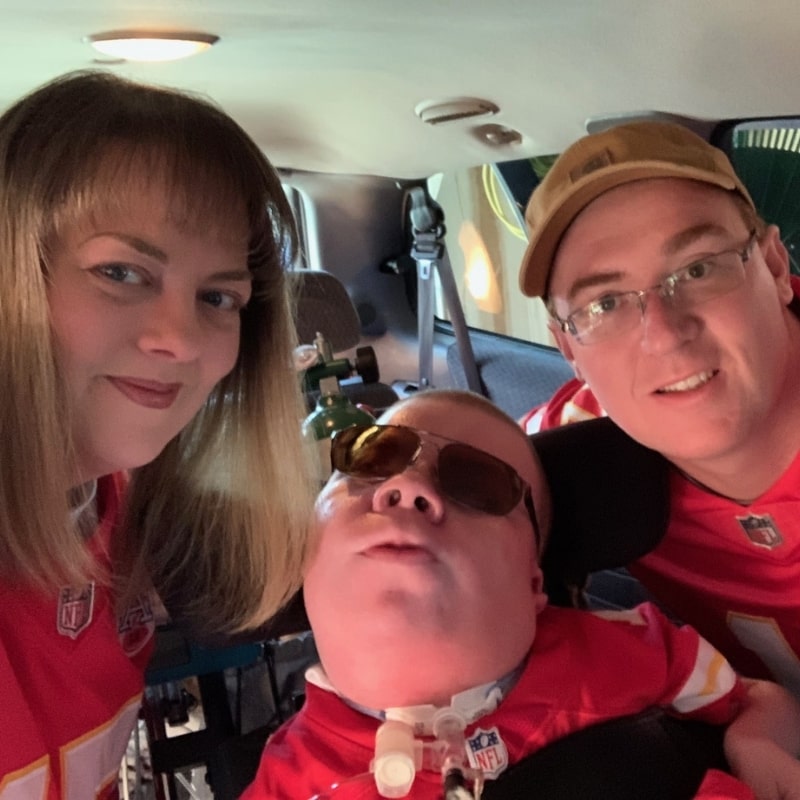
Written by SOWLE RV
September 30, 2018
Learn Strategies for Successful RV Camping
Our G.O.A.L. at SOWLE RV is to “Get Out And Live” and explore the world around us. “Learn Strategies for Successful RV Camping for Beginners” is for beginners as well as for those of you who are looking for an improved RV Camping experience.
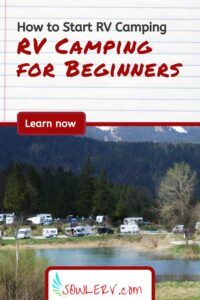
What Stage are YOU in for RV Camping?
Whether you’re new to the idea of RV Camping, a seasoned RVer looking to purchase a new one, or would just like more information, tips, and tricks from what we have learned in our experience with MANY YEARS of RV Camping, we will show and tell you all you need to know!
If you’ve never even considered RV Camping, stick around! We may just give you a whole new outlook on what “camping” has become and get you hooked like we are now! No matter where you are in your RV Journey, there is a perfect RV for YOU out there!
We are giving you helpful strategies to know where to begin as well as information on the different types of RVs and floorplans available. You will need to spend some time deciding exactly what YOUR Perfect RV may look like for you and your family and this can be done by filling out our FREE Questionnaire included in all of the information to come! This will allow you to Get Out And Live and explore the World Around You! So, let’s get started, shall we!
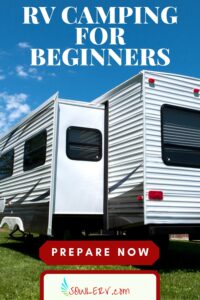
The Basics of an RV: What is an RV?
Let’s start with the basics. A Recreational Vehicle (AKA RV) is a trailer or a motorized vehicle that includes living quarters much like all the accommodations you would have in a home. There are 6 different classes of RVs available. They include:
- Travel Trailers
- 5th-Wheels
- Toy Haulers
- Expandable Trailers
- Destination Trailers
- Motorhomes
As previously stated, a typical RV includes all the accommodations you are used to at home such as a kitchen, bathroom, living room, and at least one sleeping area.
Nowadays, almost all RVs also include at least 1 air conditioning unit, a water heater, a television, and some will even have 1 or more Slide-Outs. Just like the name, a Slide-Out is an area that, when parked, slides out to create additional living space. When it’s time to travel again, you simply slide the slide-out back in with the touch of a button!
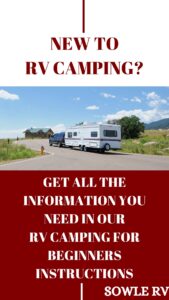
What is an RV Used For?
Most people use a Recreational Vehicle for an occasional camping trip.
A new trend is to use them as a family’s main residence, or Full-Time RVing. This is also especially true for people who are retired and prefer to travel to warmer locations in the winter months known in the RV Camping world as “snowbirding”.
Another new trend is to use them with solar panels which allow families to use their RV anywhere without worrying about finding a place to “hook-up” for electricity and other amenities. This is known as “Boondocking”. We will get into the details of all that later though! For now, let’s continue to focus on the RV itself!
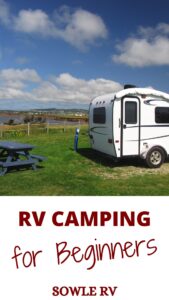
The Different Classes of Recreational Vehicles Explained
As mentioned earlier, there are 6 different classes of RVs. Here they are with a little more detail.
Travel Trailer Recreational Vehicle
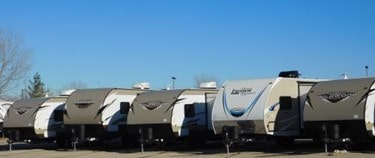
The Travel Trailer is a recreational vehicle with all the amenities like at home. Typically, it will include a kitchen, dining room, living room, bathroom, and bedroom. It is attached to a towing vehicle such as an SUV or even a car if it’s a smaller Trailer. Then when stationary, it can easily be unattached to free up the towing vehicle for other activities.
Fifth-Wheel Recreational Vehicle
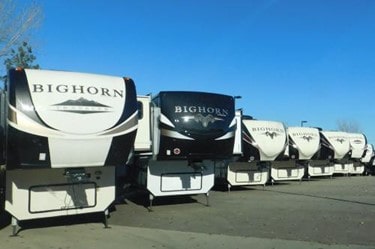
The Fifth Wheel is a Travel Trailer with an extended front area that adds an extra-large living area. That area is supported by a special hitch in the center of a pickup truck instead of the back of a vehicle. It’s like an 18-wheeler layout, only smaller. When stationary, the fifth wheel is then easily detached from the towing vehicle. This makes it very convenient to do other activities like the Travel Trailer.
Toy Hauler Recreational Vehicle
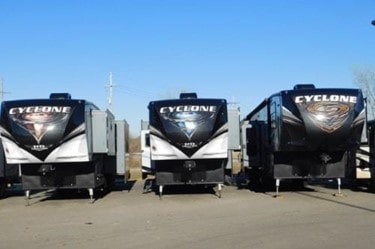
The Toy Hauler has a living space like the travel trailer or fifth wheel. Additionally, it has a large opening to a cargo area with a ramp either on the side or the rear of the RV trailer. This area allows the owner to transport larger equipment such as an ATV or other outdoor toys.
A Toy Hauler is an option for a Travel Trailer or a Fifth Wheel. It also reduces the time spent loading the RV through a typical door opening. It conveniently can add more sleeping quarters, an extra bathroom, and/or a dining area separate from the main living area.
Expandable Recreational Vehicle
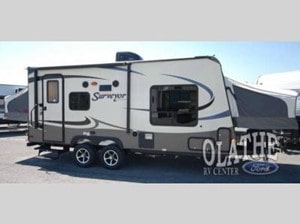
The Expandable RV is a small travel trailer. It also has one or more tent-like sections that expand outward to create a larger living space. Typically, the expanded space is to create more sleeping space either on both the front and rear or on one end and one side of the travel trailer. These RVs tend to give the owner a feeling of “tent camping” with the luxury and security of a stable trailer as well.
Destination Trailer
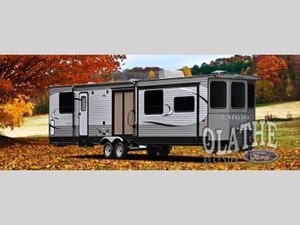
The Destination Trailer is a much heavier RV and is designed to be towed by a larger vehicle and then parked. It is then left to be stationary for the season or even year-round. People sometimes confuse the Destination Trailer with a Park Model Trailer, but it does have one important key difference. The difference is the Destination Trailer is self-contained and DOES include waste holding tanks and freshwater tanks. A Park Model Trailer is not self-contained and does not include holding tanks or freshwater tanks. The Destination Trailer is designed for people who want a stationary place to camp either at a campground or park and is not meant for traveling.
The Classes of Motorhomes
A Motorhome is just like the other Recreational Vehicles as far as amenities are concerned. However, as its name represents, it has a motor of its own and does not require an additional vehicle to tow it. The Motorhome is great for traveling.
Class A
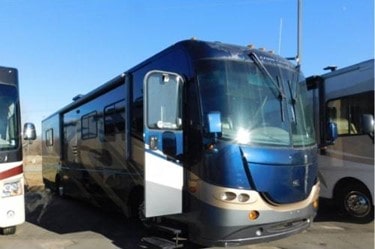
The Class A Motorhome is a large, bus-style motorized Recreational Vehicle. The amenities are much like what you will find in a Fifth-Wheel or Travel Trailer.
These RVs have become a favorite for many RVers because they can drive them anywhere, tow a vehicle behind, and have smaller transportation once they’ve arrived at their destination.
These RVs are built on a very heavy-duty frame. It is known for its quality and luxury in the RV world. The Class A is known as the “house on wheels”.
Class B (AKA Campervan)
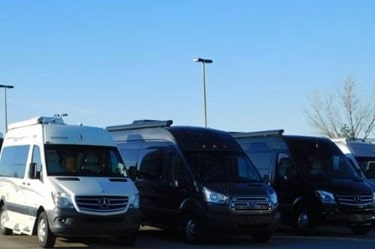
A Class B, also referred to as a Campervan, is a motorized vehicle that provides transportation with sleeping accommodation as well. It is a van with a raised roof, either a pop-up roof that is raised only while camping or stationary or a fixed raised roof.
The Class B usually has all the amenities of a home, just much, much smaller.
It typically has a kitchen area that contains a small refrigerator, microwave, and some type of grill. It also has a bathroom area; however, the bathroom is usually a combination of shower and toilet as one, unlike the larger RVs that have the shower as a separate shower stall.
The sleeping area has at least one bed. Some double as a daytime seating area or living room type area with a TV. There’s not a lot of room for moving around in the Class B, however, it is great for traveling!
Class C
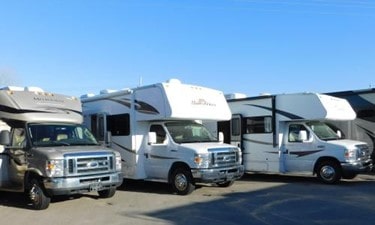
The Class C Motorhome is the “in-between RV” of the Class A and the Class B. It’s not as large as the bus-style Class A but much larger than the van-style Class B.
It typically has a separate bedroom, living, kitchen, and bathroom areas. The bathroom has a fully separate shower stall as well. There is much more room to move about in the Class C from the Class B but not as much as the Class A.
Are you following what we are saying here with all these Motorhome Classes??
Simply put, Class A is the size of a large bus, Class B is the size of a van, and Class C is somewhere in-between!
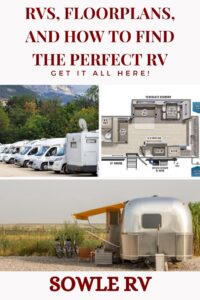
Understanding RV Floorplans
Understanding RV Floorplans is the first step to ensuring you get everything you want in an RV as well as ensuring that those options are available in the RV Floorplan you are considering. That is why we are breaking some floorplans down for you step-by-step to ensure you get what you want!
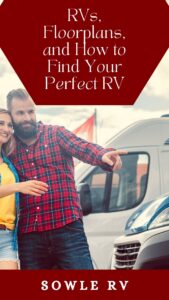
What are RV Floorplans?
Just like building a “sticks and bricks” home is built from a floorplan, all RVs start with the same idea. Floorplans can look very different between each manufacturer, brand, and model. Therefore, we thought it would be a good idea to give you the “basics” of the floorplans before digging into the details of them all.
How To Read RV Floorplans
Below you will see a floorplan for a Travel Trailer, Fifth Wheel, Toyhauler, Class A, Class B, and Class C Motorhomes. In addition, they are all broken down into sections and explained in detail. Hopefully, Understanding RV Camper Trailer Floorplans will be much easier after reading this.
Travel Trailer Floorplan
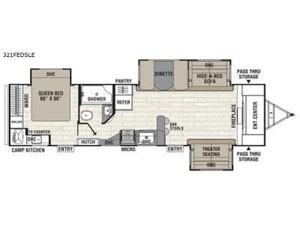

First, the Rear Bedroom of this Floorplan shows a Wardrobe, a Queen Size Bed with size, Over Head Cabinets for storage, and TV Area. It also shows a grill, camp kitchen, and one of 2 Entry Doors.
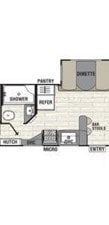
Next, this section shows the Bathroom including the Toilet, Sink, and Full-Size Shower. A hutch is featured across from the bathroom with Over Head Cabinets between hutch and Microwave in the Kitchen. Additionally, the Kitchen Area shows the Refrigerator/Freezer, Oven, Pantry, Sink, and Dinette type (booth) and bar stools at the eat-in-kitchen bar. The 2nd Entry door is shown as well.
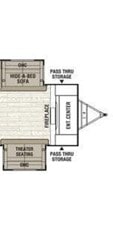
Therefore, the Living Area is at the front of this RV and has an Entertainment Center at the very front with a fireplace. It also shows Over Head Cabinets above the Hide-A-Bed Sofa and also above the Theatre Seating. Finally, it shows the Exterior Pass-Thru Storage.
Fifth Wheel Floorplan
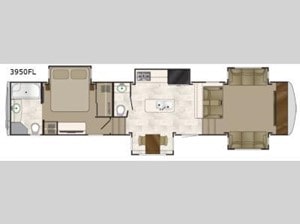
![]()
First, this 5th Wheel has a bathroom the entire width of the rear of the RV and shows a large Shower, Toilet, Storage, and Sink.

Next, the Bedroom has a bed-head slide out and small tables built in on each side. Additionally, there is a dresser at the foot of the bed against the wall with a TV above the dresser. Beside the dresser is a closet. There is more closet space beside the bed as well as Washer/Dryer Prep.
Once you go up the stairs, there is a 1/2 Bathroom with Toilet and Sink. The Kitchen is next with a table and 2 chairs in one slideout. An Island with Sink in the middle. The Oven/Stove and Refrigerator/Freezer are in the other slide out.

Finally, this 5th Wheel has a Front Living Area meaning you go up more stairs to reach the Living Area. It has an Entertainment Center at the front, with a Sofa on Each Side each in its own slideout. The Theatre Seating is directly across from the Entertainment Center.
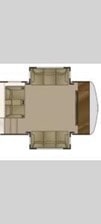
Toyhauler Floorplan
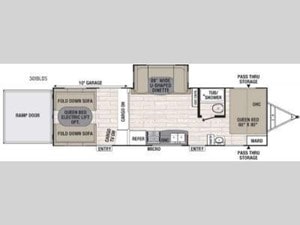
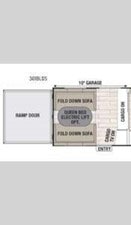
The Toyhauler has a ramp at the rear of the RV that comes down from the top. It shows a 10’ garage that includes a fold down sofa on each side with a queen bed on an electric lift as an option. There is an entry door, TV Overhead, and Cargo Overhead Storage next to it.

Next, there is a U-Shaped dinette in the slideout with an Entertainment Center just outside the slideout. Across from the dinette is the kitchen area with Refrigerator/Freezer, Microwave above the Oven/Stove, a double Sink and Over Head Cabinets. There is a Tub/Shower and Toilet in the bathroom, however, the Sink and storage are located across from the bathroom. Finally, there is another Entry door in this area.

In conclusion, the Bedroom area is at the front of this RV and shows a Queen Bed with size listed. Above the bed are Over Head Cabinets and a wardrobe is next to the bed. It also shows Exterior Pass-Thru Storage. This RV has linoleum or wood floors throughout.
Class A Motorhome Floorplan
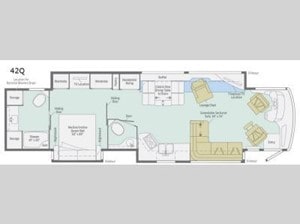

This Class A Motorhome has a rear Bathroom with storage on both sides of the sink. A Shower is shown with size and the Toilet.

Next, the Bedroom has a slideout at the bed head and also a slideout across from the foot of the bed that extends that entire length of the RV before it reaches the Cab Area. It also has 2 wardrobes and a TV Area. A 1/2 Bathroom with a Toilet and Sink is across from a pantry and the Refrigerator/Freezer beside it.
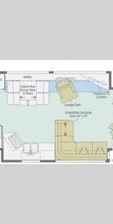
Next. is a dinette in the extended slideout across from the kitchen area that is also in a slideout and has a double Sink and Oven/Stove. Additionally, the next space has an L-Shaped Sofa and Recliner Chair.

Finally, we see the Cab area with the Driver and Passenger Seats.
Class B Motorhome Floorplan
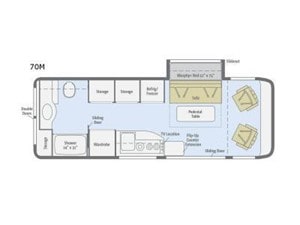
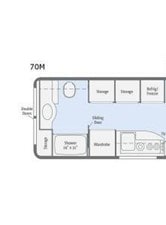
This Class B Motorhome has double doors at the rear. In the Bathroom is a Shower, Toilet, Sink, and storage. There is a sliding door between the Bathroom and Kitchen Area. Lots of storage and Refrigerator/Freezer is on one side and a Wardrobe, then Kitchen with Sink and Oven/Stove on the other side.
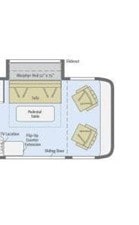
Next, in the Living Area is a Sofa in a slide out with a Murphy Bed that folds up above it. A removable table is in the middle. There is a sliding “van” door across from the Sofa. Finally, the front is the Cab Area with Driver and Passenger Seats.
Class C Motorhome Floorplan
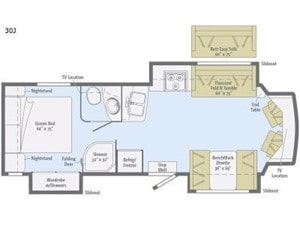
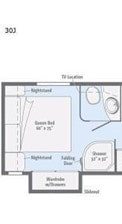
This Class C Motorhome has a Queen Size bed at the rear with nightstands on either side. A Wardrobe with drawers in the Bedroom slideout. However, the Bathroom is split, therefore, the Toilet and Sink are on one side and the Shower is on the opposite side.
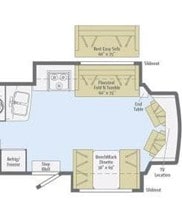
Next is the Kitchen Area that has a Refrigerator/Freezer to the left inside of the Step Well Entry to the RV. Additionally, across from that, is the Sink and Oven/Stove. After that is the Dinette that is to the right of the Step Well in a slideout. In addition, there is a Sofa with an End Table in the opposite slideout with a “Fold N Tumble” above it. Finally, the Cab Area has the Driver and Passenger Seats with the TV located above them.
How to Find YOUR Perfect RV
Does the thought of searching for an RV and then learning how to use it overwhelm you? How about the idea of learning how to drive a motorhome or pulling a trailer?
We have been RV Camping for many, many years, in fact, since before we were married, even more, since we were kids. We have purchased many used RV’s since we were first married, however, when it came time for us to purchase a brand-new RV (the 2nd time, because the first time was a disaster), it was a bit overwhelming.
Nevertheless, the excitement soon took over and instead of going into it blindly, we decided to make a list of exactly what we WANTED and NEEDED in an RV and as a result, ended up with the perfect RV for our family. Therefore, we decided to give our best advice to all of you as encouragement to be determined not to settle but to find the PERFECT RV FOR YOU too!
Truly finding the perfect RV for YOU and YOUR FAMILY is the most important thing for a great RV Camping experience. We finally found our Perfect RV, however, like we mentioned earlier, it was AFTER we made quite a few mistakes and purchased a brand new RV and ended up trading it in less than a year later, which resulted in a large financial loss.
We don’t want to see you go through that, so we created what we wish had been available to us before we made that big mistake and that is this FREE Checklist and Questionnaire or Finding the Perfect RV for You!
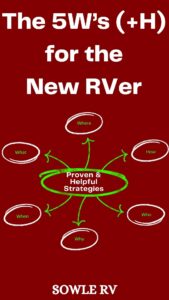
The 5W’s (+H) Proven & Helpful Strategies for the New RVer
We have been asked many questions about RV Camping over the many years we have been doing it. For this purpose, we came up with the basic questions to ask yourself as a new RVer called The 5W’s (+H) Proven & Helpful Strategies for the New RVer!
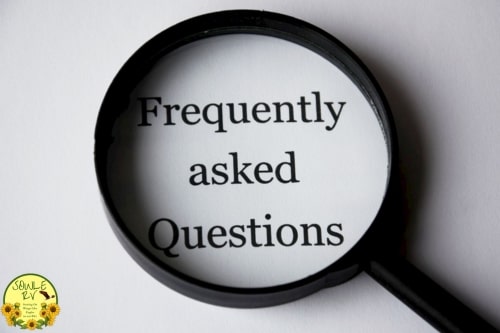
These are the Frequently Asked Questions “Who, What, Where, When, Why, and How’s” of RV Camping.

Who will use this RV for Camping?
If you are totally new to this entire “camping thing” you may not even have a “style” yet but thinking about what type of RV’er you PLAN to be will be helpful in the long run when you’re making other decisions.
Are you single and plan to RV that way?
Are you a retired couple but may have grandchildren join you in RVing from time to time?
Do you have a large family with lots of kiddos who LOVE the idea of this whole camping thing?
What about pets? We have 6 Chihuahua’s so that was a HUGE factor in space. (I know they’re tiny, but consider 20 PAWS AT YOUR FEET and you WILL be looking for more space!

What Type of RVer are you?
The next question to ask yourself is what TYPE of RV’er are you planning to be?
For this purpose, we will compare two VERY different types of RVing.
For example, there are “Glampers” and there are “Boondockers”, then there are all of those in between! Deciding where you fit in between or far to one side or the other will be helpful in determining the kind of RV you will need as well as it will be helpful in many other areas we will discuss later.
For now, lets take a closer look at our example we are using between a Glamper and a Boondocker…
What is Glamping?
Glamping is defined-yes, it’s in the dictionary- as “a form of RV Camping involving accommodation and facilities more luxurious than those associated with traditional camping.” It’s Glamourous Camping! However, one person’s idea of glamour may differ from others.
What is Boondocking?
Boondocking, also known as “Dry Camping,” is basically RV Camping without hookups. No electricity, no water, and no sewer. Although some chose to use a generator for power and fresh-water tanks filled full for water so you’re not necessarily going TOTALLY without amenities.
The In-Between RVer
The In-Between RVer is just like it sounds, someone who is not totally glamping in an incredibly ridiculously expensive RV but not boondocking to the point of having no amenities available. This is the category that most RVers fall into.

Where do you plan to go RV Camping?
It may seem a bit early to think about WHERE you plan to go RV Camping if you haven’t even purchased an RV, however, there additional things to take into consideration if you plan to go RV Camping in National Parks or Resorts. There can be size restrictions on the length of RV’s allowed in the campground as well as the year of the RV restrictions.
Size Restrictions
The maximum allowed length of an RV varies from park to park. Typically, the maximum length can be between 20’ to 40’ but the average length is 27’. That is a VERY large difference between 20’ to 40’ so the best thing to do is think about where you PLAN to go RV Camping and check that specific campground for rules on length. The last thing you want to happen is to travel to your destination only to find out your RV isn’t allowed!
Year Restrictions
Whether right or wrong, there are also year restrictions at some RV Resorts. They can make their own rules and they do. Some require your RV not be over 10 years old. Most campgrounds and parks are not like this but it’s always best to check the campground rules BEFORE heading out! Consequently, if most of the locations you plan to go RV Camping at have either of these guidelines, you may have to purchase a shorter or newer RV. Just something to think about…

When do you plan to use your RV the most?
What season you use your RV can play a role in the kind of RV you purchase. There are many different RV Packages available and understanding what you are getting with those packages is very important.
The Seasonal Role
Choosing the right RV Package is especially important if you plan to go RV Camping in the Winter Months, but can be just as important if you plan to go RV Camping in very hot temperature conditions as well. Unfortunately, these packages tend to differ quite a bit between manufacturers, so YOU MUST ASK exactly what the package includes when looking into an RV.

Why A Motorhome or Pull-behind Trailer?
What you need to consider with a Motorhome purchase
If you are looking into purchasing a Motorhome, you need to consider what you will use to get around once your RV is parked and setup at the campground. Will you tow a vehicle behind the Motorhome? How will you tow it? On a dolly? Flat tow? What are the requirements for towing a vehicle? Is a Tow Bar needed? Is there a special Receiver Hitch needed?
Towing a vehicle behind your Motorhome certainly opens your trip up to more freedom to go anywhere once Motorhome is setup but considering the above questions is something you must do before deciding on your final purchase.
What you need to consider with a Pull-Behind Trailer
If you are looking more into a Pull-Behind Trailer such as a Travel Trailer, Fifth-Wheel, Toy Hauler, or Expandable RV, what will you use to pull it? Is there a special receiver hitch needed? Do you need a Tow Bar? What are the weight limitations on your vehicle of choice? How much does the RV weigh? Again, answering these questions is something that must be done before making that final purchase.

How are you planning to use your RV?
There are basically 3 different way people tend to use their RV.
Those 3 are as a Full-Time RVer, a Part-Time RVer, or a Weekend Warrior and are self-explanatory.
Full-Time RVer
A full-time RVer is someone who spends 365 days (or most of the year) living in their RV. In other words, their RV is their home.
Part-Time RVer
A part-time RVer is someone who spends part of their time in an RV and the other part of their time in a house, apartment, or “Sticks and Bricks” as referred to by most RVers.
Weekend Warrior
A Weekend Warrior is someone who spends as many weekends as possible in their RV.
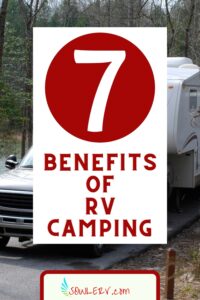
7 Benefits of RV Camping
These are the 7 Benefits of RV Camping That May Change Your Perspective if you’re on the fence about giving it a try.
- Bring the comforts of home with you
- Family flexibility
- Education for kids
- Vacation available with many options of where to go
- Save money from hotels as campsites are less expensive
- Save money on dining…bring your own food and grill
- Bring your pets along
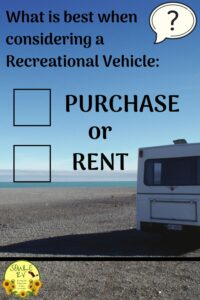
HOW TO DECIDE IF IT’S BEST TO RENT OR PURCHASE AN RV
There are Pros and Cons for both renting an RV and Purchasing an RV. Unfortunately, it’s not a simple decision to make for some people. That is why we came up with this very simple list of reasons why you may want to purchase an RV and a list of why you may want to rent first. Here’s How to Decide if it is Best to Rent or Purchase an RV-SOWLE RV.
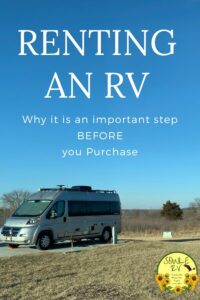
WHY RENTING AN RV MAY BE A GOOD IDEA
Renting an RV may be a good idea for several reasons. Here’s a list of those reasons if you…
- Have never been RV Camping
- Have very specific needs in an RV
- Made travel plans but don’t like the cost or feel of a hotel rental
- Will only be RV Camping a few weekends out of the year
- Are considering an RV purchase but are not sure which type of RV you should purchase
WHY PURCHASING AN RV MAY BE YOUR BEST CHOICE
Purchasing an RV may be the best choice for you. Here’s a list of those reasons if you…
- Have been RV Camping and enjoyed it
- Already have rented a few different RV’s and know what your specific needs are and that they can be met in an RV
- Don’t want to pay rental fees that can add up and would prefer to own an RV
- Have plans to use it at least most of the spring, summer, and fall months
- Already have an idea of what type of RV you want and are ready to narrow it down to a specific brand/model
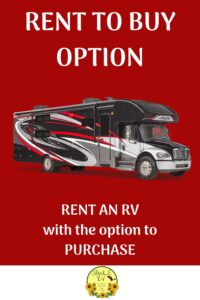
RENT TO BUY OPTION
Renting to buy an RV (or own) is a lease just like a car lease. There are a few Rent to Buy Options from different RV Rental Companies. There are also some private sellers who offer this as an option.
To find out more about renting to buy an RV in your area, first try a search for “RV dealers near me” and check if they offer a Rent to Buy option.
Cruise America (an RV Rental company for United States and Canada) states that they will apply up to two weeks-time and mileage charges towards the purchase of a Cruise America Motorhome.
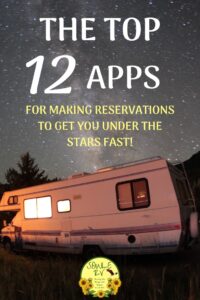
How to Make RV Camping Reservations Including Apps for Support
Figuring out how to make RV Camping Reservations can be a daunting task. Online reservations are our favorite because they’re easiest for us, however, sometimes there can be computer glitches and reservations get mixed up. That’s why it’s very important to remember to verify your reservations once more before you head in that direction. Now, on to how to make RV Camping Reservations!
The Top 12 Apps for Making Reservations to get You Under the Stars Fast!
#1: RA Camping FREE (we use for state campgrounds)
#2: Park Advisor FREE
#3: Campendium FREE (we use for everything)
#4: Camp USA FREE
#5: Allstays $9.99 (we use for everything)
Membership APPs
#6: Passport America FREE
For KOA and Good Sam use their Apps for searching and Reserveamerica.com or RA Camping App to make a reservation
#7: KOA FREE
#8: Good Sam Camping FREE
For Encore RV and Thousand Trails Searching and Reservations use their combined website at www.RVonthego.com
Apps for Renting an RV
Although we personally have never rented an RV, we have heard that the FREE #9 Outdoorsy APP is best for RV Rentals, so give them a try!
No App for That?
Online reservations are great; however, some campgrounds just don’t like to use them and require you to call to make reservations. Every campground has its own rules for making reservations, so once you decide on where to go, just check their information on their website for details on how to make those reservations.
Boondocking Apps
Although we cannot Boondock (because we have way too much medical equipment we use), here are a couple great Boondocking Apps for you to try:
#10: Harvest Hosts FREE
#11: Boondocking FREE
Save Money on Gas
Another great App to remember when you’re on the road and traveling is the FREE Gas Buddy App! If you allow location services while using this App, it tells you the cheapest places to get gas close to you!
FREE FOR ALL APPS!
If you’re looking for all of the awesome FREE RV Apps out there, check out our MUST HAVE FREE RV APPS article!
How to Set Up and Tear Down an RV Campsite [including what to do when you arrive]
It’s important to have an RV Camping routine designed to help you remember all the things that must be done when you set up your campsite. This is a routine that you can use upon arrival at the campground as well as when you are ready to leave and tear down your campsite to head home. Knowing how to set up and tear down an RV campsite can save you time and potentially save you from stress and money issues while being prepared at your campsite. Here are 7 Steps for How to Set Up and Tear Down an RV Campsite [including what to do when you arrive]
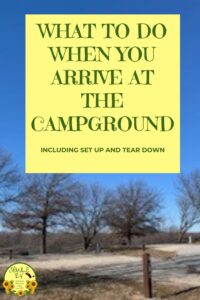
What to do when Arriving at a Campground
- If no reservations have been made, find a site that is not reserved.
- Find Camp Host (Usually Camp Hosts are incredibly helpful and want to make your camping experience a great one. If you’re a beginner RVer, simply ask the Camp Host any questions you have and I’m sure they will be happy to assist you in any way they can).
- Check in with the Camp Host and pay for the site.
- Drive to your campsite and put placard on post (if given one).
- Always check the campsite BEFORE pulling into it for any debris such as a nail or anything that could be potentially harmful to your vehicle(s) or you.
- Locate the hookups (sewer, water, and electricity) before pulling into the campsite.
- Pull-in (or back-in) to your campsite.
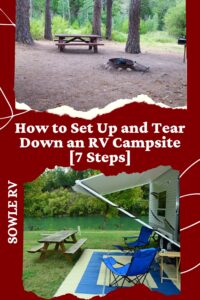
How to Set Up a Campsite
- Visually check to see how far off the RV is from being level.
- If needed, level the RV with blocks.
- Chock the wheels to secure.
- Disconnect the trailer from the tow vehicle at this stage (if a travel trailer).
- After the RV is level, put down the stabilizing jacks.
- Hookup your RV to Electricity, Water, and Sewer.
- Setup interior and exterior amenities such as chairs, camping rug, and pull out the awning if desired. Remember to add chemicals to the toilet (aqua chem).
How to Tear Down a Campsite
- Collect all trash from campsite and put it in dumpster. Check the campsite and ensure it is like you originally found it.
- If you have pets, remember to clean up after them.
- Pull up stabilizing jacks.
- Empty the black tank and grey tank if at a sewer site (if not, obviously this step is done at the dump station).
- Disconnect the water hose and drain it.
- Disconnect from electricity.
- Attach trailer to towing vehicle and hook up to safety chains and emergency breakaway cable.
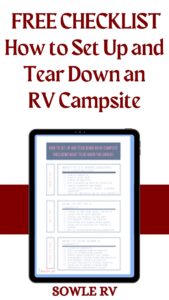
Print out the sheet below and laminate it to easily check off tasks completed every RV Camping Trip!
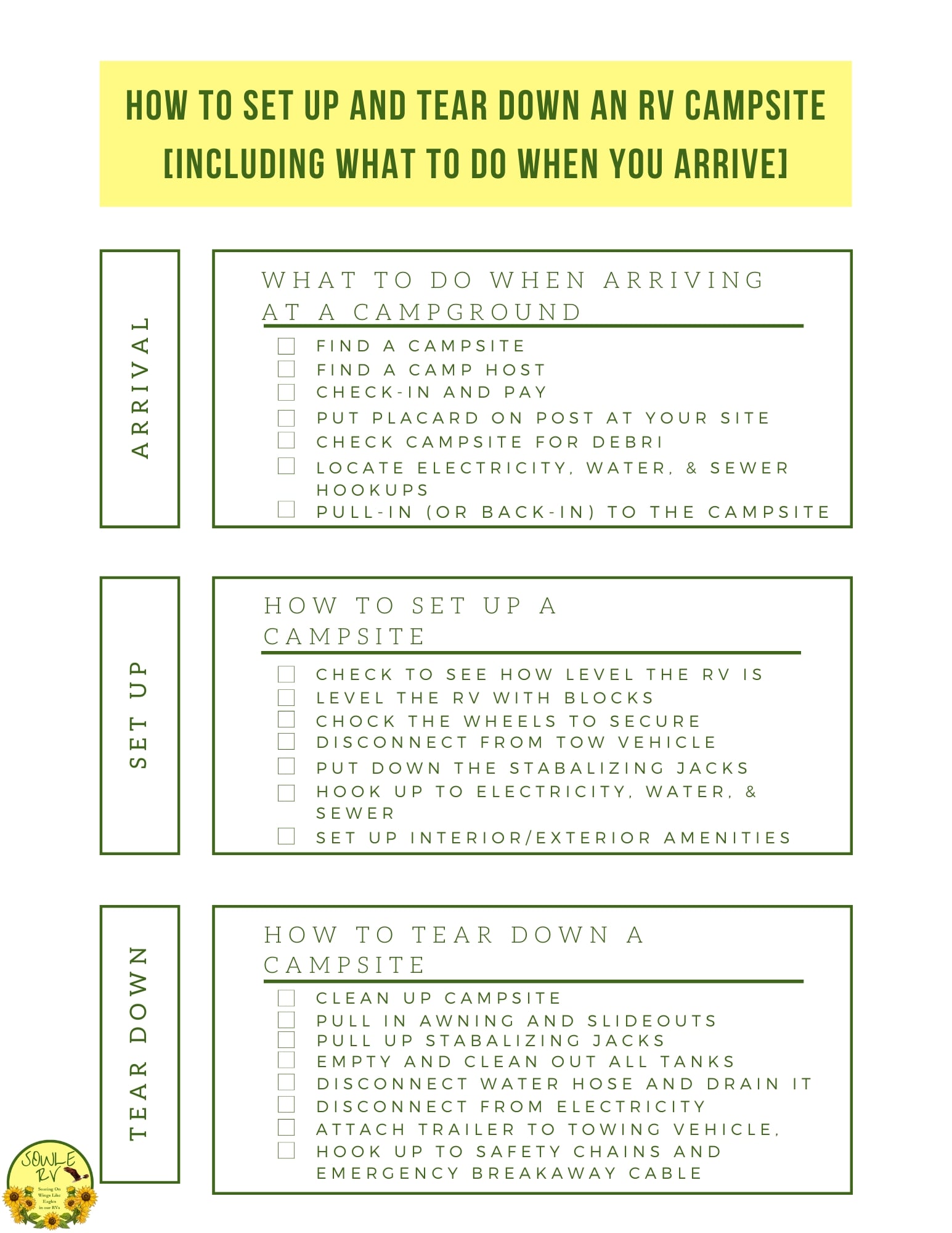
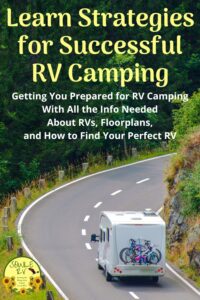
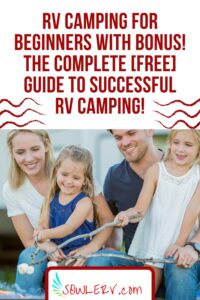
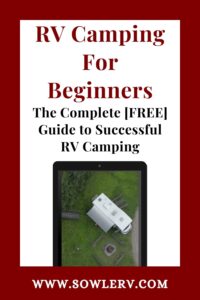
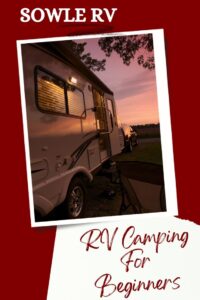
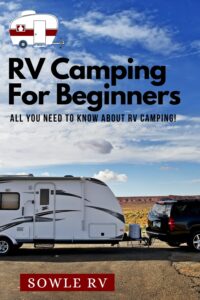
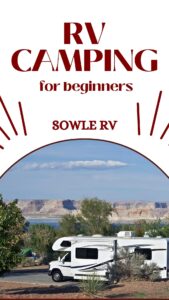
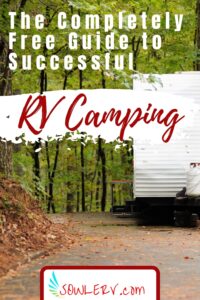
Related Articles
7 Reasons Why THIS is the Best Portable Barbecue Grill for RV Camping!
7 Reasons Why THIS is the Best Portable Barbecue Grill for RV Camping! We needed to purchase a new Portable BBQ Grill to use with our Motorhome for when we get to go RV Camping again. We researched MANY barbecue grills trying to find the best barbecue grill for RV...
The 12 Important Steps for Towing an RV Safely [Bonus Important Safety Tips for Towing a Boat with a Truck Camper and How to Back Up an RV Trailer]
Hey everybody, Mark here along with Angie to tell you about The 12 Important Steps for Towing an RV Safely with 2 Bonuses of Important Safety Tips for Towing a Boat with a Truck Camper and How to Back up an RV Trailer! Understanding and following these safety tips...
How to Easily Change Out the Door Lock on an RV
How to Easily Change Out the Door Lock on an RV As part of the SOWLE RV series "What You Need to Know NOW to be a Safe RVer", this is also part of our Maintenance and Safety series, and we are going to show you How to Easily Change Out the Door Lock on an RV. We are...
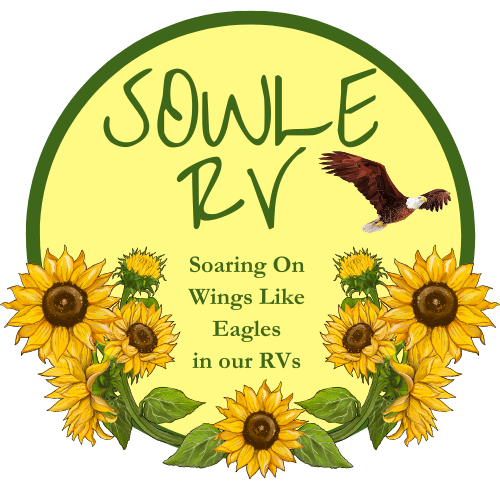
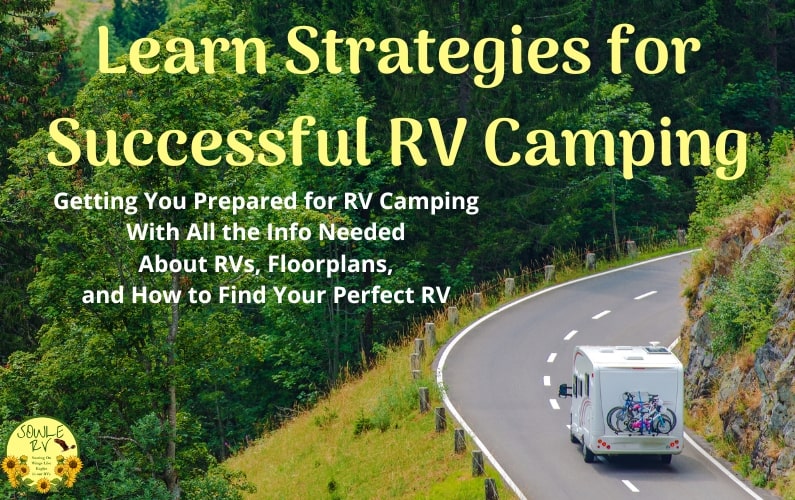
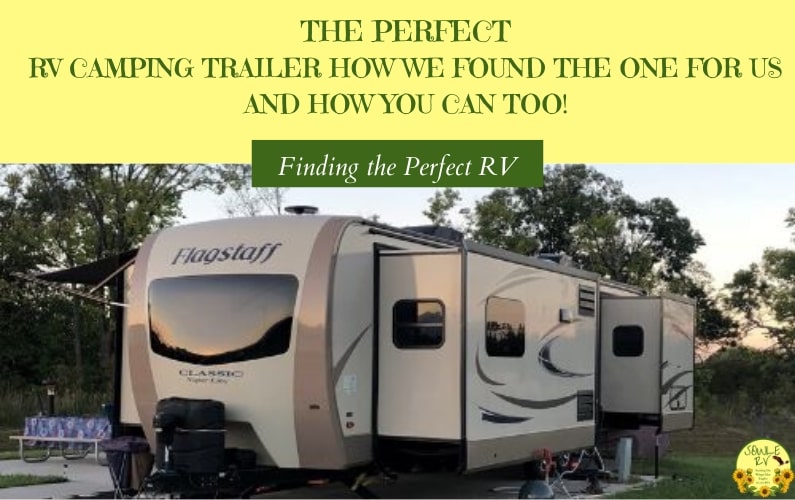
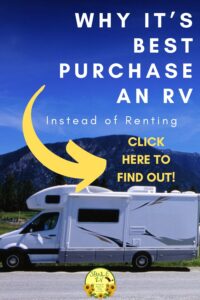
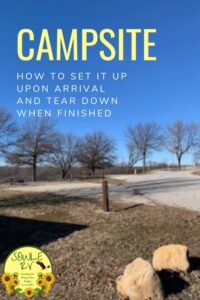
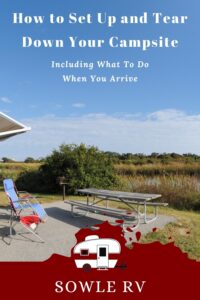

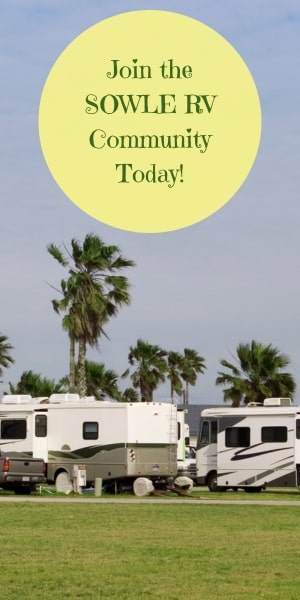
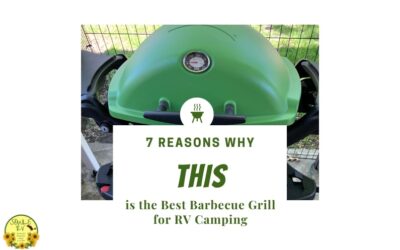
![The 12 Important Steps for Towing an RV Safely [Bonus Important Safety Tips for Towing a Boat with a Truck Camper and How to Back Up an RV Trailer]](https://sowlerv.com/wp-content/uploads/2024/03/How-to-pull-an-RV-Trailer-SOWLE-RV-min-400x250.jpg)

